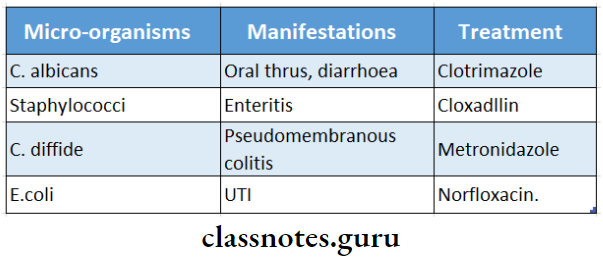General Considerations Important Notes
1. Antibiotics
- Antibiotics are biological substances elaborated by microorganisms that suppress the growth of other microorganisms or destroy them in high dilution
2. Classification of antibiotics
- Based on the mechanism of action
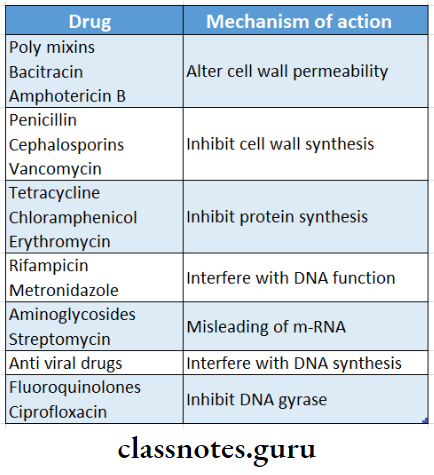
General pharmacology questions and answers
- Based on antibacterial activity
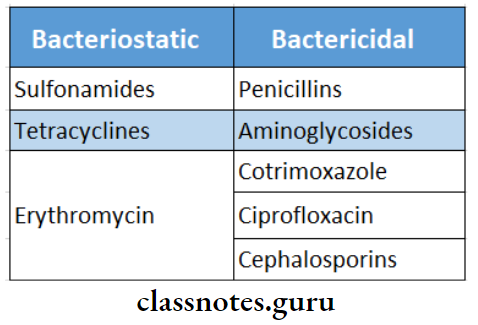
Read And Learn More: Pharmacology Question and Answers
- Based on the spectrum of activity
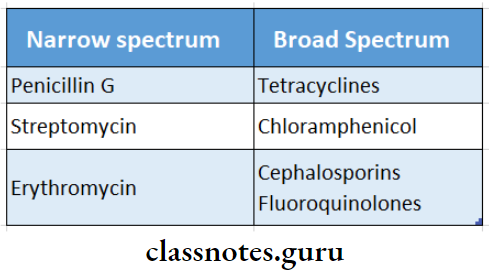
3. Superinfection
- It refers to the appearance of a new infection as a result of antimicrobial therapy
- Drugs that cause superinfection are
- Tetracyclines
- Chloramphenicol
- Ampicillin
- Amoxycillin
4. Methods to prevent drug resistance
- Indiscriminate, inadequate, and prolonged use of antibiotics should be avoided
- The drug should be given after a culture sensitivity test
- If antibiotics are to be given for a prolonged period, combination therapy should be instituted
5. Uses of a combination of drugs
- To achieve synergism
- To reduce the severity or incidence of adverse effects
- To prevent the emergence of resistance
- To broaden the spectrum of antimicrobial action
Pharmacology general considerations PDF
6. Examples of a combination of drugs
- A combination of two bacteriostatic drugs that are often additive and rarely synergistic
- Tetracycline + chloramphenicol/ erythromycin
- Sulfonamide + trimethoprim
- Clavulanic acid + amoxicillin
- A combination of two bacteriocidal drugs that are frequently additive and sometimes synergistic
- Penicillin/ ampicillin + streptomycin/ gentamycin
- Carbenicillin + gentamycin
- Ceftazidine + ciprofloxacin
- Rifampicin + tuberculosis
- Combination of bacteriostatic and bacteriocidal drugs
- Penicillin + erythromycin
- Penicillin + tetracycline/ chloramphenicol
- Penicillin + sulfonamide
- Streptomycin + tetracycline
- Rifampicin + dapsone
General Considerations Long Essays
Question 1. Mention some examples of antibodies and describe the mechanism of action and side effects of two commonly used antibiotics.
Answer:
Antibiotics:
- Antibiotics are produced by microorganisms that selectively suppress the growth or kill other microorganisms at very low concentrations.
Antibiotics Classification:
1. Based on chemical structure.
- Sulfonamides – sulfones, dapsone.
- Diaminopyrimidines – trimethoprim.
- Quinolones – nalidixic acid, norfloxacin.
- β-lactam antibiotics – penicillin, cephalosporin.
- Tetracyclines – Oxytetracyclines.
- Aminoglycosides – streptomycin, gentamicin.
- Macrolide – erythromycin, Azithromycin.
- Polyene antibiotics – Nystatin.
- Azole derivatives – clotrimazole, ketoconazole.
2. Based on the mechanism of action.
- Inhibit cell wall synthesis.
- Penicillin, cephalosporins.
- Causes leakage from the cell membrane.
- Polypeptides – polymyxins, colistin.
- Inhibit protein synthesis.
- Tetracyclines, chloramphenicol.
- Causes misreading of mRNA
- Aminoglycosides.
- Inhibit DNA gyrase – fluoroquinolones.
- Interfere with DNA function – Rifampicin.
- Interfere with DNA synthase – Acyclovir.
- Interfere with intermediary metabolism.
- Sulfonamides, trimethoprim.
Introduction to Pharmacology Q&A
3. Based on the type of organisms against which it acts.
- Antibacterial – Penicillin, aminoglycosides.
- Antifungal – Griseofulvin, Amphotericin B.
- Antiviral – Acyclovir, Amantadine.
- Antiprotozoal – Chloroquine, metronidazole, chloroquine.
- Anti-helmintic – Mebendazole.
4. Based on the spectrum of activity.
- Narrow spectrum – Penicillin G, streptomycin.
- Broad spectrum – Tetracyclines.
5. Based on the type of action.
- Bacteriostatic – sulphonamides, tetracyclines.
- Bacteriocidal – Penicillins, Aminoglycosides.
Antibiotics Penicillins:
Penicillins Mechanism of action:
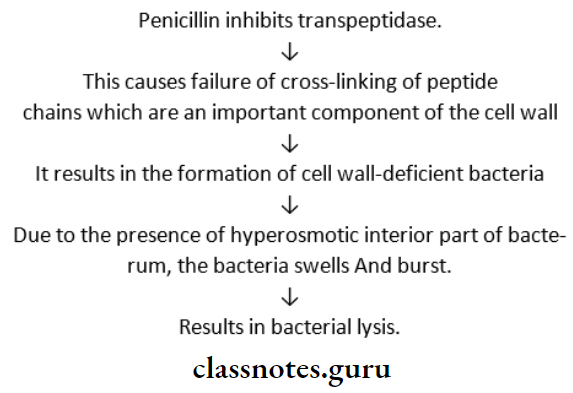
Penicillins Adverse effects:
1. Hypersensitivity reactions.
- Skin rashes, urticaria, fever, bronchospasm, serum sickness, and anaphylaxis.
2. Paint the site of injection.
3. CNS effects.
- Confusion, muscle twitching, convulsions, coma.
4. Suprainfection.
5. Jarisch-Herxheimer reaction.
- Occurs when penicillin is injected into the syphilitic patient
- It is characterized by the sudden destruction of spirochete chapters and the release of its lytic products.
Antibiotics Sulfonamides:
Sulfonamides Mechanism of action:
- Many bacteria synthesize their own folic acid from p-aminobenzoic acid (PABA) by the enzyme folic acid synthetase.
- Sulfonamides are structurally similar to PABA.
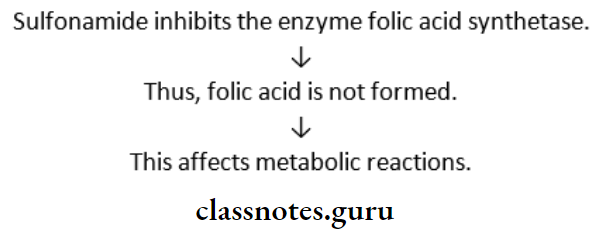
- Thus, sulphonamide is bacteriostatic in action.
General pharmacology question bank
Sulfonamides Adverse effects:
- Nausea, vomiting, epigastric pain.
- Renal Irritation, hematuria, albuminuria, and crystalluria.
- Hypersensitivity reactions.
- Kernicterus.
- Hemolysis in G-6 PD deficiency patients.
- Hepatitis.
- Stomatitis, conjunctivitis, And Arthritis
Question 2. Explain four advantages of the combined use of antimicrobials with examples.
Answer:
Advantages of a combination of antimicrobials:
1. To achieve synergism.
- The same drugs may be synergistic for one organism but antagonistic for another.
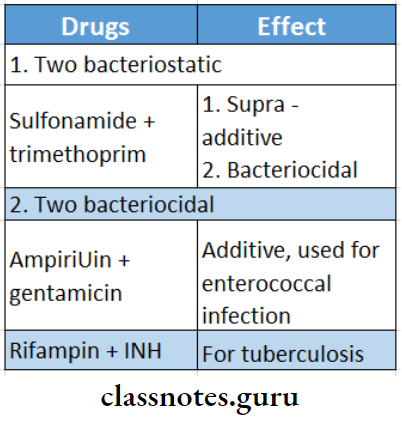
2. To reduce adverse effects.
- Combining two antimicrobials may reduce the dose of each agent.
- This may thereby reduce the toxicity of drugs.
- Example: Streptomycin + penicillin G for subacute bacterial endocarditis.
3. To prevent the emergence of resistance.
- It is used primarily for chronic infections needing prolonged therapy, like tuberculosis and leprosy.
- Rifampin + ciprofloxacin – prevents S.aureus resistance.
4. To broaden the spectrum of antimicrobial action.
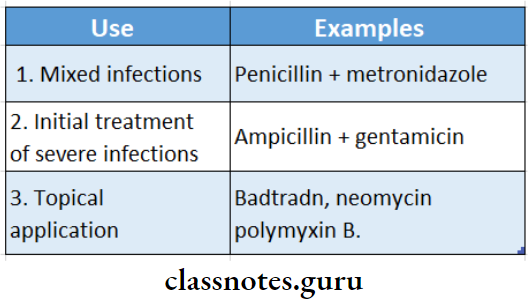
General principles of pharmacology questions
General Considerations Short Essays
Question 1. What is superinfection? Give two examples.
Answer:
Superinfection:
- It refers to the appearance of a new infection as a result of antimicrobial therapy.
Superinfection Reason:
- Antimicrobial agents cause alterations in the normal flora of the intestine, respiratory, and genitourinary tracts.
- Normal microbial flora contributes to host defense.
- In it, the pathogen has to compete with the normal commensals for nutrition.
- But by the use of antimicrobial agents, there is a lack of competition.
- As a result, infection is caused easily.
- The broader the antimicrobial spectrum, the greater the chances of superinfection.
Conditions Predisposing to Superinfection:
- Corticosteroid therapy.
- Leukemia.
- AIDS.
- Agranulocytosis.
- Diabetes.
- Disseminated lupus erythematosus.
Superinfection Examples:
